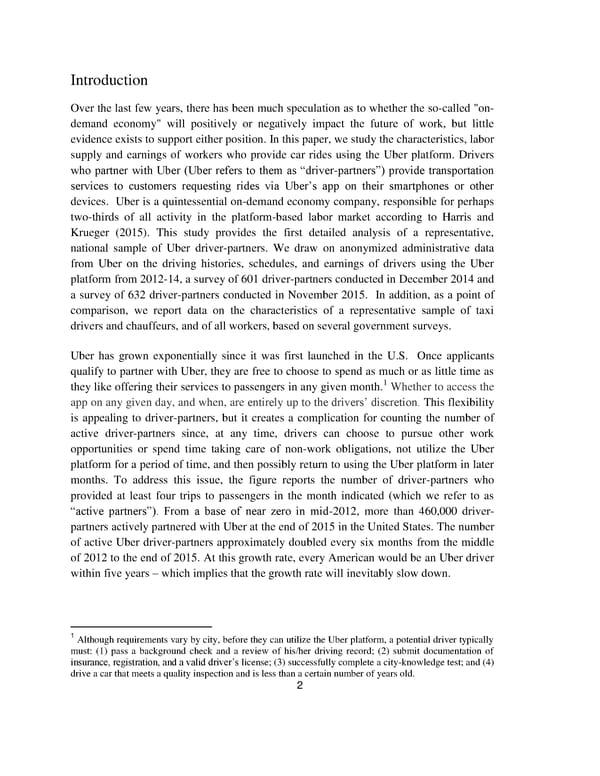Introduction Over the last few years, there has been much speculation as to whether the so-called "on- demand economy" will positively or negatively impact the future of work, but little evidence exists to support either position. In this paper, we study the characteristics, labor supply and earnings of workers who provide car rides using the Uber platform. Drivers who partner with Uber (Uber refers to them as “driver-partners”) provide transportation services to customers requesting rides via Uber’s app on their smartphones or other devices. Uber is a quintessential on-demand economy company, responsible for perhaps two-thirds of all activity in the platform-based labor market according to Harris and Krueger (2015). This study provides the first detailed analysis of a representative, national sample of Uber driver-partners. We draw on anonymized administrative data from Uber on the driving histories, schedules, and earnings of drivers using the Uber platform from 2012-14, a survey of 601 driver-partners conducted in December 2014 and a survey of 632 driver-partners conducted in November 2015. In addition, as a point of comparison, we report data on the characteristics of a representative sample of taxi drivers and chauffeurs, and of all workers, based on several government surveys. Uber has grown exponentially since it was first launched in the U.S. Once applicants qualify to partner with Uber, they are free to choose to spend as much or as little time as they like offering their services to passengers in any given month.1 Whether to access the app on any given day, and when, are entirely up to the drivers’ discretion. This flexibility is appealing to driver-partners, but it creates a complication for counting the number of active driver-partners since, at any time, drivers can choose to pursue other work opportunities or spend time taking care of non-work obligations, not utilize the Uber platform for a period of time, and then possibly return to using the Uber platform in later months. To address this issue, the figure reports the number of driver-partners who provided at least four trips to passengers in the month indicated (which we refer to as “active partners”). From a base of near zero in mid-2012, more than 460,000 driver- partners actively partnered with Uber at the end of 2015 in the United States. The number of active Uber driver-partners approximately doubled every six months from the middle of 2012 to the end of 2015. At this growth rate, every American would be an Uber driver within five years – which implies that the growth rate will inevitably slow down. 1 Although requirements vary by city, before they can utilize the Uber platform, a potential driver typically must: (1) pass a background check and a review of his/her driving record; (2) submit documentation of insurance, registration, and a valid driver’s license; (3) successfully complete a city-knowledge test; and (4) drive a car that meets a quality inspection and is less than a certain number of years old. 2
 An Analysis Of The Labor Market For Uber’s Driver-partners In The United States Page 2 Page 4
An Analysis Of The Labor Market For Uber’s Driver-partners In The United States Page 2 Page 4